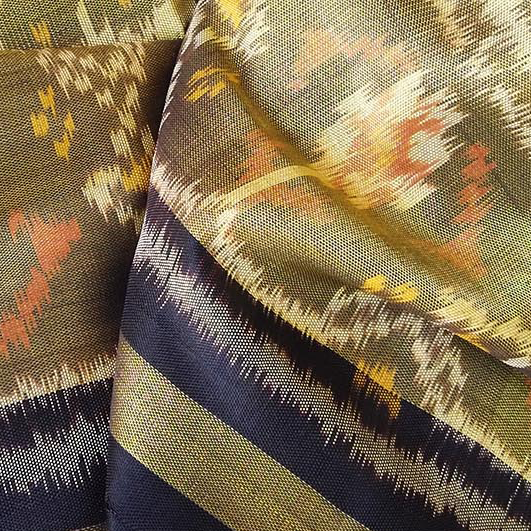Patola saris are a double ikat woven sari, usually made from silk, made in Patan, Gujarat, India. The word Patola is the plural form—The singular is patulu. They are very expensive, once worn only by royalty and the aristocracy, they are popular and in demand from those whocan afford them. Velvet patola styles are also made in Surat. Patola-weaving is a closely guarded family tradition. There are three families left in Patan that weave these highly prized double ikat saris. It can take six months to one year to make one sari. The craft of weaving them rests exclusively with the Salvi family in Patan who manufacture Patolas for royalty and aristocracy.
In Double ikat both warp & weft is dyed before the weaving begins. This requires expertise and pin-point accuracy as displacement of even one thread may result in a deformed pattern on the cloth.
They are so unique that they are the geographical indication tags for Gujarat as Patan Patolas and Andhra Pradesh as Bhoodan Pochampally.
History :
Patola has a royal history. Silk weavers of the salvi caste from the states of Karnataka and Maharashtra chose Gujarat as the home for their renowned patola fabric. It is believed that salvis went to Gujurat in the 12th century with the intention of acquiring the patronage of the Solanki Rajputs, who ruled all of Gujarat and parts of Malva and south Rajasthan at the time, with Anahiwad Patan as the capital.

Legend says that over seven hundred patola weavers came to the palace of Raja Kumarapala. At that time the ruler used to dress in patola silk himself on special occasions. After the decline of the Solanki empire, the salvis founded a rich trade in Gujarat. Patola saris quickly became a sign of social status among Gujarati women and girls, especially as part of stridhan, items that a woman can claim as her own property within a marital household.
Features of Patan Patola :
1. Equal design and wearable on both sides. Even weavers can’t identify which is the front or back once the weaving is over.
2. Only 3 families in Pattan make them today, out of the original 700 families.
3. Around 3 people take 4 to 6 months to weave one saree which is 5.5 meters long and 48 inches wide.
4. No computers or power looms are used. Mental calculations, deep concentration, patience, undivided attention and a lot of hard work are the skill sets that make one saree.
5. The measurement tapes used by the weavers (which can measure up to 100th part of an inch) are the same which were invented 1000 years ago.
6. Made only in silk (patt is short for ‘Pattakalam’ which means silk in Sanskrit) as it lasts 80 to 100 years. They consider making it in cotton a waste of their time as it will tear in 40 to 50 years.
7. Their cheapest saree starts at 1.5 lac rupees and takes 1.5 to 2 years for delivery. For people who do not want to spend that much they have options of Dupattas (40 to 50,000/- rupees) or handkerchiefs (3 to 4,000/- rupees). A good Patola costs Rs. 3 lacs.
8. Colours last for over 300 years.
9. They do use chemicals to dye for their lower end sarees but also use pure vegetable dyes for patrons who do not mind the escalated cost.


3 comments
Like to see more of patrols sarees
Wow!!!!really amazing lists of sarees….this is very useful to the people who doesn’t have any ideas about the sarees….the description about the Ikat sarees is wonderful…thank you for posting…keep blogging!!
Fabulous design and good combination of colours